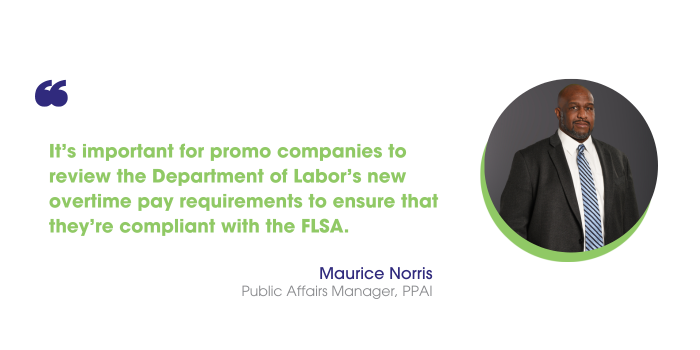Federal Government Releases New Overtime Exemption Rule

An extra four million salaried workers in the United States will be eligible for overtime pay after the U.S. Department of Labor released its long-awaited final rule on overtime exemptions on Tuesday.
Titled “Defining and Delimiting the Exemptions for Executive, Administrative, Professional, OutsideSales and Computer Employees,” the rule increases the salary thresholds required to exempt a salaried bona fide executive, administrative or professional employee from federal overtime pay requirements under the Fair Labor Standards Act (FLSA).
- Proposed in September 2023, the rule is scheduled to go into effect on July 1, 2024.
- However, the rule is likely to be challenged in court.
Maurice Norris, PPAI’s public affairs manager, says that the rule is moving rapidly from proposal to finalization, at least by federal agency standards.
“While there are procedural and electoral motivations at play, on the practical side it’s important to remember two dates: July 1, 2024, and January 1, 2025,” Norris says.

“These two dates, one of which is approaching in just over two months, both involve new overtime pay thresholds affecting a combined four million workers. It’s important for promo companies to review the Department of Labor’s new overtime pay requirements to ensure that they’re compliant with the FLSA.”
New Salary Thresholds
The rule will raise the present annual salary threshold of $35,568 to the equivalent of a $43,888 annual salary on July 1, based on existing methodology used by the Trump administration, and then to the equivalent of $58,656 on January 1, 2025, based on a new methodology.
The rule also raises the overtime salary threshold for highly compensated employees to $132,964 in July and $151,164 in January, up from the current rate of $107,432.
- Starting July 1, 2027, salary thresholds will update every three years, by applying up-to-date wage data to determine new salary levels.
“This rule will restore the promise to workers that if you work more than 40 hours in a week, you should be paid more for that time,” says Acting Secretary of Labor Julie Su. “Too often, lower-paid salaried workers are doing the same job as their hourly counterparts but are spending more time away from their families for no additional pay. That’s unacceptable.”
Legal Challenges
As previously mentioned, there’s a history of rules raising the salary threshold being challenged in court.
In 2017, a federal judge in Texas struck down an Obama administration rule that would have extended mandatory overtime pay to more than four million workers after 21 states and several business groups had challenged it, Reuters reported.
Meanwhile, the challenge to the Trump administration rule is still ongoing in the Fifth Circuit after a lower court ruled in favor of the federal government.
- Despite the final rule being issued, the case will proceed.
“The Department of Labor is ensuring that lower-paid salaried workers receive their hard-earned pay or get much-deserved time back with their families,” says Wage and Hour Administrator Jessica Looman. “This rule establishes clear, predictable guidance for employers on how to pay employees for overtime hours and provides more economic security to the millions of people working long hours without overtime pay.”

